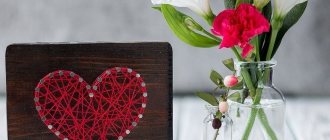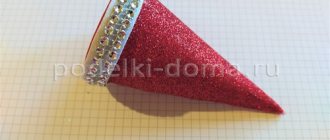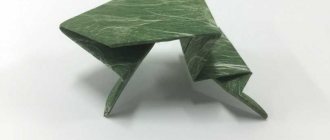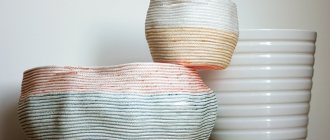Limitless variety
Despite the contrast of its components, the craft is undoubtedly worthy of praise and touches the eyes of true connoisseurs of handmade work. The compositions can be so different and unique that from a distance you can’t immediately make out all the details, but when you get closer, the painstaking work of the author makes you think about repeating such manipulations in person.
Nitcography
A type of arts and crafts that is essentially a flat appliqué made of threads. But these are no longer just crafts made from yarn - you create an amazing picture with your own hands, filled with play of colors, light and shadow, visual volume and picturesqueness.
The work is done on a flat base. The most detailed linear sketch is drawn on it, which is subsequently filled in with woolen threads of various lengths.
The result of this painstaking work is amazing. Without a doubt, it can be considered a work of art! Not only is it not a shame to give such a painting as a gift, it deserves a place at the exhibition!
Whatever technique young or mature artists choose, whatever level of skill they possess, they are intertwined and connected by the love of creativity! This is the red thread of their life - wool, silk, iris, floss - inspiring and calling for new creative achievements.
Borrowed four centuries ago
The string art direction came from England; the art is not new, but is popular due to its spectacular design and originality. In the past, people used wickerwork on metal parts to add variety to their homes and give their rooms interesting decor. Boards of non-standard sizes were taken, onto which the desired design was subsequently applied; the finished craft decorated one of the walls of the living room or office.
Letter Design Combined with String Art
Letter design is a long-known interior trend; it was introduced by Western designers. Letters, words, phrases - all these elements are quite appropriate in decor, and in combination with threads and nails they turn into stylish voluminous home decorations.
Absolutely any letters on the wall will enliven the interior! And if they form a word, for example, a meaningful “OK” - that’s even better)
The original master class is in English, so for your convenience we offer a brief translation of the process of creating this painting.
Materials and tools are standard: blue threads, brush, hammer, scissors, nails, dotted sketch on paper, tape.
Print the templates, glue the word from A4 sheets. Place the sketch on the base and drive nails into the points on the drawing. Remove the sketch from the base.
Tie a knot on the first nail and start winding the thread around the perimeter of the pattern (letters “OK”).
Creating letter outlines
Next, wind the threads around the resulting letters, gradually filling the background. You can wind the thread randomly, or you can wind it in a certain specified order. Don't forget to change the color of the threads according to the chosen color scheme!
Filling the background
This composition is made according to the same principle. The marine theme in letter-string design will appeal to everyone who loves the delicate color combination of blue and white)
Such a heartfelt personalized gift will definitely pleasantly surprise)
Author: Belarusian craftsman Alexander Andriyanov
A bright accent in a delicate children's room can be given by a panel with a very important word on it!) An alternative could be a similar panel with the name of the owner of the room or other warm words)
Despite the sharp nails, the String Art style can be very gentle)
Tenderness is in hardness
Love can be expressed by anything
How do you like such a bright greeting in the living room?)
Or a soulful picture in the hallway:
Home Sweet Home
Hallway sign
As they say “Don't worry – be happy!” String Art will help bring positivity into every home!)
Multifaceted development
Surprisingly, Mary Bull used string art patterns to improve her students’ knowledge of algebra and geometry, the classes gave positive results and the popularity of weaving spread throughout the world. Now this technique is widely used to embody unique landscapes that decorate houses and apartments; various competitions and exhibitions are held where exhibits of the highest quality are presented.
Templates
Those who are starting to work on a painting using the string art technique for the first time do not need to come up with a plot on their own. Ready-made templates will help you acquire the required skills, the use of which facilitates the learning process. The handmaker needs to pay all attention to the correctness of the weave in order to fill the corners efficiently and create arcs and circles.
It is the templates that will help you master the basic techniques of string art.
This includes filling and forming elements such as:
- circle;
- circle;
- corner;
- arc.
This knowledge and skill will help you create a wavy relief, a complex pattern of threads of different colors, filled figures with contrasting edging.
Using the same template, you can make several different paintings, filling all the elements with threads of the same color, using threads of different colors and shades, of different qualities and different thicknesses. In another version, the main one is an arc, in another - a wide circle or ring, the design remains empty, and the entire free area of the base is woven with threads, driving nails not only along the contour of the image, but also along the entire perimeter of the board or cardboard.
Getting started is easy
Regardless of age, with a great desire to try yourself in something new and interesting, string art for beginners is available to everyone. You can buy all the necessary things in specialized stores or take improvised means. The initial design can be made on one of the following bases:
- Wooden.
- Cardboard.
- Foam.
- Cork.
Every beginner should try all possible suggestions, this will help to settle on the most practical and continue to create with convenience. For joint activities with children and personal training, it is better to take cheap ones; in case of failure or mistakes, you will be able to avoid unnecessary costs and worries.
Additional decor of compositions
Rod caps can serve as additional decoration. They go well with the edging, giving the composition the appearance of an outline framed by a string of beads. An interesting decor option is a photo used as the bottom layer. The background serves as a frame for the unusual design.
If the picture is thematic, additional decor can be materials close to the theme: natural, improvised, etc. An example is an image of a fish, dolphin, mermaid, complemented by shells glued to the base. The flower can be supplemented with an artificial butterfly pinned to the core, etc. Rhinestones, sparkles and even LEDs inserted into pre-prepared holes and connected to a power source are suitable as decoration for inscriptions and drawings.
You can decorate the picture with a painted background. It needs to be painted in advance, before creating the web. After drying, the work is carried out according to standard rules.
We add uniqueness to forms
The shape also needs to be changed, depending on the goal, thanks to various geometric shapes, you can create a real masterpiece that will fit into any room and interior.
Of the available items and components, the following should be noted:
- Hammer.
- Small carnations.
- Sandpaper.
- Paint or varnish.
- Multi-colored threads.
Working on a cleaned surface will be more pleasant and convenient. If the intended image does not require it, the background for the panel made of threads and nails occupies a special place in the durability of the entire structure. Cork material may not require strong hammering of the metal frame, which cannot be said about oak boards; you cannot do without a hammer. A large tool is not needed; working with it is not very convenient when it comes to small patterns.
Materials and tools for string art
Before you start creating a masterpiece. It is necessary to prepare all the tools and materials that the master will need while working on a painting, postcard or decorative panel. But first, you should prepare your workplace.
The solution to this problem should be approached by thoroughly thinking through all the nuances:
- Lighting.
- Place and method of attaching the base.
- Table and chair matching each other in height.
- A stand or shelf for storing tools and materials.
- Garbage container.
It is impossible to complete the job without preparing a convenient tool. In the process of creating even a small painting, you will have to drive nails into the hard surface of the base with the utmost care, so you will need a light hammer.
The master’s hand should not experience significant tension, which means that a large, heavy tool cannot be used.
Wood varnish will be needed to prepare the working surface. Accordingly, you need to take care of purchasing a high-quality brush that does not lose bristles during use, and a sufficient amount of solvent to clean the brush after completing the preparatory work.
If a child will do the work, then polystyrene foam or cardboard is used as a base. The materials are quite light and comfortable. Foam does not require additional coating. As for cardboard, you can make it brighter using a water-based stain.
In order to transfer a template (bitmap, sketch) to the prepared surface of the base, you need to stock up on copy paper. Pliers will be needed to hold or remove nails. Using scissors, the master will trim the ends of the threads, the quality of which depends on the characteristics of the future image.
Bobbin sewing threads are used to create light, airy weaves, iris will help make the picture bright, nylon cord is necessary to create graphic designs. Using fishing line, they make a background when working on a plot canvas. The threads are chosen long enough and strong enough. It is impossible to tie a thread that is torn during the process due to strong tension. There should be no knots on the finished product.
A regular ballpoint pen will help make the process of tightening the thread easier and more convenient. It is enough to remove the rod, make a hole in the cap and thread the selected thread, which will be used during work.
Add brightness to art technology
You can use paints of different shades depending on the chosen theme. The varnish applied on top will protect the coating during wet cleaning of the room. As for the metal components, there should be a lot of them. The smallest creations require a minimum of 20 pieces; decorative items, furniture or carpentry types are suitable.
Note!
- How to make wooden shelves with your own hands - original design options
- Kinusaiga technique for beginners: what is it, a description of creating paintings from threads
- How to weave a figurine from rubber bands: how to learn to weave animals, toys and what you can make from rubber bands on a slingshot
Design assistance
At the initial stages of constructing paintings from threads, you can use templates and diagrams; novice needlework lovers will learn useful tips from the finished example. They show all the steps in detail using printed digital symbols; from the abundance of options, everyone is sure to find one that suits them.
Note!
- How to make flowers from cold porcelain: chic floristry and DIY crafts for the New Year step by step
- How to make cold porcelain from potato, corn starch, liquid, without soda. Recipes and cooking methods
- How to properly make a birdhouse with your own hands from scrap materials: we create an original birdhouse according to sketches
A ballpoint pen without a refill or any hollow, cone-shaped object that is comfortable to hold with your fingertips works well for winding.
String art technique on plywood
It goes well with paints and stains, achieving the ideal effect is easy and quick. There are times when the background looks nice even without adding shades to it; each artist independently chooses the best option for the future landscape.
Choosing string art for creativity will mean that you have a difficult choice, the abundance of products can easily take you by surprise, and it’s very easy to get confused in front of the counter. All kinds of colors, density and structure attract the eye with their beauty and perfection; you can take a closer look at the following proposals:
- Floss;
- Iris;
- Twisted.
It doesn’t matter what the choice is, but everyone who decides to weave pictures with threads on nails should know that they need extremely strong material, otherwise all the efforts and painstaking work will bring disappointment with numerous impulses.
Features of creating paintings
First you need to decide what kind of pattern you want to create, think about the dimensions, number of colors, and other parameters. Often ready-made diagrams from magazines are used - these are inscriptions, silhouettes, plot drawings. Pictures with “tips” will be useful for beginners. The most important point in creating a thread pattern is tensioning the threads. It is advisable to do this not too tightly so that the nails do not bend, but not too weakly either. Only strong threads are used - if the material breaks, it is tied, and the resulting knots spoil the appearance of the product.
If you need to get a rich color, a larger number of threads are wound in a certain area. When using several shades of the same color, the threads intersect each other, forming soft gradient transitions.
How deep should you drive the nails?
All nails are driven in to the same depth, at an equal distance from each other. The height of the part protruding above the surface is five to nine mm. When driving in nails, use small forceps or pliers - this way there is less chance of damaging your fingers. After the painting is completed, it is permissible to drive the nails deeper, although this is not at all necessary.
How to change thread color
When winding the thread, its beginning is secured to the first nail with a knot. When it runs out or you need to change the color, a neat knot is also made. The new thread starts again from the knot. After finishing the work, all the “tails” are cut off and glued inside out to make them unnoticeable.
Using the same pattern, using different colors and thread placement options, it’s easy to create completely different paintings.
Options for filling the picture
When the nails are already filled along a certain contour and perimeter of the board, there are two filling options. In the first, the interior is filled, in the second, the background. There is a third option, when the middle is decorated with threads of one color, the edges - with others. The threads do not necessarily intersect in many places. For example, if the outline is square (round) and the middle is in the shape of a heart (circle), the lines run in different directions side by side, like rays from the sun. The use of several overlapping thread colors allows you to create beautiful shades. To create a light, openwork pattern, thin sewing threads are used, wool yarn is used for more voluminous work.
Edging the picture
The edging is a dense, usually contrasting outline of the design. It is performed by entwining carnations with a “snake”. The outlines are often made with a thicker, denser thread, while the filling is made with thinner threads. Sometimes the edging is made just two or three tones darker (lighter) than the figure itself, which looks especially beautiful when creating realistic paintings.
How to create multi-layer compositions
Complex, two-three-color, multi-color compositions can also be created using this technique. If we take an image of an animal or a bird as an example, then first the main color of the creature’s body is woven into the picture, then the contours, paws, spots on the “fur” are made, and lastly the eyes and noses are made. To give the color an interesting shade, threads of similar tones of the same color are used.
There are no mistakes!
Those people who do nothing do not make mistakes. If any defects or irregularities occur, everything can be carefully corrected. In order to remove a bent or jammed metal object in the wrong place, you should use pliers or scissors. A pre-prepared tool will facilitate coordinated processes in creating crafts from nails and threads.
How to further decorate the picture
As additional decor in crafts made from threads with nails, paints are used to decorate the substrate, decorative attachments for the heads of nails, beads, rhinestones, and glitter in the form of a spray. The finished painting is placed in a frame made of wood, metal, plastic, cardboard, or other material. Additional parts made of paper, textiles, leather are secured with glue. The heads of the nails are sometimes painted to match the threads, less often - in a sharply contrasting color. Often used are jute “tassels”, satin ribbon bows, paper, dry (varnished) or polymer clay flowers, all kinds of rivets, “gifts of the forest”, such as acorns, pine cones, dry hawthorn, rowan, etc.
New Year's string art
On the eve of the holiday, string art for the New Year will be an excellent option for people who have tried, it would seem, all possible decorations. A thematic performance will give guests a truly magical mood on the night of December 31st; with a handicraft master class, the room where the feast will take place can be transformed before our eyes.
Owners of a cafe or bar will also find excellent logos and images for their establishment that match the style and decor. Oak with a cup of hot drink at the entrance will definitely interest potential customers, and revenue will only grow. There is no need to spend a lot of money on such mini-advertising, and the effect will be noticeable the next day.
Note!
- How to properly make a birdhouse with your own hands from scrap materials: we create an original birdhouse according to sketches
How to make candles with your own hands: instructions for making wax, gel, scented, homemade decorative candles with a wick
- What you can make from foamiran with your own hands: we create flowers, Christmas tree decorations, snowflakes, three-dimensional paintings (photo + video)
Master classes for beginners and more - sketches, diagrams
The basic patterns for making circles, corners, and arcs using the String Art technique are not at all complicated, but their proper combination makes it possible to create almost any image. But it is important to pull each thread correctly, otherwise the picture will be ruined. Each thread is pulled tightly enough so that it does not sag over time.
The most popular image options:
- flowers, snowflakes;
- hearts, stars;
- leaves, trees;
- letters, words, inscriptions;
- animals, birds, fish;
- still lifes with fruits, bouquets;
- portraits of people;
- world map, starry sky.
When working with nails and a foam base, do not pull the thread too tightly - the parts may fall out and the picture will be ruined.
Snowflake
Snowflakes are the most popular decoration for New Year and Christmas. In the String Art technique it is performed like this:
- an elegant six-pointed snowflake is drawn on a square or round piece of paper;
- the drawing is applied to the plywood;
- nails are driven into the board to create a suitable contour;
- white or pale blue threads are used, sometimes two colors at the same time;
- wrapping is done starting from the middle; The more often the nails are filled, and the thinner the threads, the more interesting the picture will look.
As New Year's decorations, a similar technique involves making snowmen, the most striking detail of the image of which will be an orange carrot nose.
Flower
Flowers are the most popular idea for any art. These include intricate rich shades of roses, lilies, violets, almost “childish” daisies, and sunflowers.
How to make fluffy dandelions step by step:
- for the work you will need about a hundred nails, a skein of white and light green threads, a wide board, a simple pencil;
- Three circles of approximately the same size are drawn on paper - these are flowers;
- then leaves and plant stems are drawn, points where carnations will subsequently be driven in are marked;
- the drawing is applied to the board, the required number of elements is driven in, the paper is removed;
- Dandelion inflorescences are “embroidered” in a circle with white thread; it is also permissible to use an overlapping pattern;
- the stems and leaves are done in green, as is the frame of the board, if required.
Light contours look most advantageous against a dark background, and vice versa.
Maple Leaf
To make a maple leaf from threads and carnations, you need to find a real, preferably large and whole, maple leaf, trace it on paper or directly on the board. To fill the outline, use almost any natural tones - spring green, emerald, brown, yellowish-brown, crimson, orange-yellow, etc. The outlines of the leaves are decorated with a darker braid, but preferably in a tone that matches the main one. The main “veins” are worked out in the same way. If desired, it is easy to create a whole “autumn bouquet” of colorful leaves.
Trees
Trees using the string art technique are made schematic or more believable. Trees, in this case, include both individual branches and an entire thread forest. Such a panel is made in black and white or multicolor. This is an oak or baobab on a greenish-brown background, a green fir tree among snow-covered forests, a sketchy eucalyptus “stuffed” right on the wall. A tree with a thick crown looks interesting, made on a board covered with a dark stain, where the texture of the wood is clearly visible. Here the background is filled with thin threads, and the main element is decorated with paper leaves, apples, cherries, and acorns.
Hearts
The heart is one of the simplest details, after a circle, square, arc. The finished product will be an excellent gift for Valentine's Day; it will decorate a bedroom, living room, or children's room, made in a romantic style. A heart is carefully drawn on paper or the board itself, dots are placed on the resulting line, in increments of about one cm. Nails are driven into the latter, and the line is erased with an eraser. Working with threads begins by tying a knot at the bottom of the heart. The winding is made at an acute angle. There is another option for executing the idea - the background is filled with a thread “web”, the heart itself is painted red and decorated with a textile or paper sticker.
Inscriptions
To create inscriptions you will need stencils of letters in Russian, English, or any other alphabet you like. They are made in capital letters or printed, and the distance between the details is sufficient so that the words are clearly readable and do not merge when viewed from a distance of several meters. This type of decor was invented and first used by the Americans.
Here is one option for creating a word:
- for work you will need a large board, a furniture board;
- All over the surface of the object, at a distance of a centimeter from each other in height and width, nails are stuffed - to make it even, the markings are applied directly to the board, using a ruler or square. If it is decided to make the outer contour round, a compass is additionally used;
- First, the letters are outlined with an outline, then the background is designed in one or more colors;
- filling is done in random order - most often strongly “broken” lines are made, but smooth transitions are also acceptable;
- the letters themselves are covered with a contrasting color scheme or left without filling;
- The finished inscription is decorated with paints, bows, paper roses, etc.
Animals
“Drawing” realistic animals with isothread is very difficult, especially when it comes to multi-color paintings. Before starting, a pencil sketch is made on paper to understand what exactly should happen in the end. Next, the drawing is simplified - the contours of individual large parts are indicated, the template is applied to the surface to be designed, and pierced with an awl in the places where the nails are driven in.
The figure of the animal, bird, fish or the background around it is filled directly. The most interesting picture ideas:
- silhouettes of different birds on a perch;
- colored fish in a round “aquarium”;
- figure of a horse with harness made of strips of leather;
- antlers of deer, elk;
- a wolf howling at the moon - dark in a white circle;
- black and white zebra – whole or only head with mane;
- an elephant in tones of terracotta and reddish-gray, stylized as an African mask;
- brooding monkey;
- roe deer with cub;
- cartoon foxes, raccoons;
- vertical triptych with a giraffe;
- fluffy kittens, puppies, rabbits, made in pastel smoky colors.
Portraits
Unique portraits using string art technique take a long time to create, but look very impressive. Such a product will be an interesting, memorable gift. The basis here is a photo of a famous person, an acquaintance, a beautiful pencil drawing from the Internet. The creation of such a picture begins not from the center, but by filling the entire background - the threads are first stretched in the darkest places (shadows, details of clothing), then the light spots (face, hands) are worked out. The main difficulty here is the use of a large number of colors, halftones, shades, which allows you to create a magnificent portrait or full-length image.
Painting individual background fragments in one color or another will give the picture volume using no more than four or five thread colors.
Personal preferences
New Year's string art is, of course, good, but even on weekdays, lovers of creativity on the theme of plants can dilute their leisure time with good varieties of flower design. The created masterpiece will definitely not be found on store shelves. Only one owner in this city will have such a thing; exclusivity makes you proud of your own design in a similar style.
Do something new
Drawings using isothread on nails are very popular; such models look quite modern and attract the attention of most connoisseurs of handicrafts. The impressive dimensions of the structures compel, admire, and arouse genuine interest in the technique of dot design; an increasing number of people are showing a desire to try their hand at it.
Such zeal is easy to explain, because the minimum effort spent on making crafts leads to stunning results, and the costs at this time are affordable for any working person.
Heart
You will need: white cotton threads, nails, hammer, sheet of paper, pencil, scissors, black satin ribbon.
Master Class
- Fold a piece of paper in half and draw half a heart.
- Cut it out and unfold it.
- Draw serifs along the contour of the heart at the same distance.
- Attach the paper heart to the board and drive the nails along the contour of the template in parallel at the same depth.
- Remove the heart template.
- Wrap the thread around the bottom stud, then wrap around the outline of the heart.
- Make vertical parallel winding, then horizontal, following the photo instructions, this heart is filled with winding threads in 4 different directions.
- Tie a ribbon bow, then attach it by decorating the heart.
The heart using the String Art technique is ready! I recommend watching this video!
Peace in progress
The hustle and bustle of weekdays, all sorts of problems in a team or a bad mood in the evening can simply be dispelled by taking out string art pattern templates and starting to weave; manipulating the blanks has a calming effect and helps you relax. The use of these skills in therapy is proof of its beneficial effects on the psyche and positive effects.
Neglecting such simple and positive opportunities is in good shape, every day will be unwise, good habits will certainly come in handy in difficult times and will help out at the most opportune moment for this. It’s better to start the preparatory steps right away, and time to start will certainly appear.
Create a panel with a deer in a rustic style
There is very little left until the New Year, the mood is rising, the cherished moment is getting closer, when the burned piece of paper with a wish written on it will fly into a glass of champagne, which will be drunk as the chimes strike and will feel so good and easy, because the New Year has come! The New Year is a new clean sheet on which you can try to write your life a little differently, in a new way. We all hope for a miracle!
In the meantime, let's create a miracle with our own hands
We will need:
- Canvas on cardboard.
- Napkins with a background New Year's motif and decoupage glue.
- Newspaper page, bookbinding cardboard, checkered sheet of paper.
- Chipboard "deer".
- Palette knife, synthetic brush, stationery knife.
- Artistic primer white and black (or black paint), whitewash.
- Texture paste, bristle brush.
- Sheet of scrap paper, stamp, glue Moment “Crystal”.
- Antique patina or brown acrylic paint.
- Finishing varnish.
- Glue a napkin with a background New Year's motif onto the canvas.
2.Glue the newspaper scraps using acrylic primer. Apply the primer with a palette knife. We try not to cover the napkin motif too much.
3. Cut out a frame from plain checkered paper. We adjust its size and location on the canvas. You can make marks with a pencil.
4. Cut out a frame from binding cardboard according to your template. I made it in two layers. For more texture
You can cut off the cardboard layer a little at the edges to imitate chipping.
5. First, cover the “planks” with black primer. Let's dry it. Cover them with a second layer of rough strokes of texture paste. Dry thoroughly.
6. Apply a third layer of white paint to the “planks”. Apply the paint tightly without adding water.
7. In the frame, I decided to place a sheet of scrapbook paper as a background. I thought for a long time about what else to add to the background. I decided to put
stamp "Postcard". I used red acrylic paint.
8. Glue a “wooden” frame and a “deer” chipboard painted with brown paint onto the base. I write a New Year's wish on the postcard with a marker.
9. Using an antique medium or highly diluted brown acrylic paint, we darken the places where the napkin motif is visible. Thus, the background seems to be stratified, the motif recedes into the background, and the areas with soil and newspaper text come forward. Add spray (I used white, red and green paints). Cover with a layer of acrylic varnish.
Our panel is ready!
I wish you all the best in the New Year! Limitless creativity, flights of imagination, strong friendship with the muse and inspiration! Create! And be happy and healthy!
Photos of patterns for paintings made of nails and threads
Please repost
0











